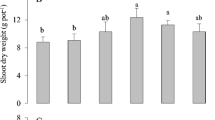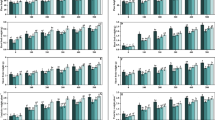Abstract
During the period January–August 1996, an investigation was carried out in La Mata, Cotuí, Dominican Republic with the objective to study the effect of P, K and Zn fertilizers on Fe toxicity in the rice varieties JUMA-57 (sensitive to Fe toxicity), ISA-40 and PSQ-4 (both tolerant to Fe toxicity). The rate of fertilizer application was 22 and 62 kg P ha−1; 58 and 116 kg K ha−1; 3 and 7 kg Zn ha−1 and a constant dose of 140 kg N ha−1 and 40 kg S ha−1 on all fertilized plots. The control received no fertilizer. JUMA-57 was the only variety that showed symptoms of Fe toxicity. The observed symptoms showed a yellow to orange colour. Symptoms of Fe toxicity appeared first one week after transplanting (WAT), decreased at the fourth WAT, but returned six WAT and continued until the end of the experiment. Fertilizer application reduced symptom intensity and increased grain yield in all varieties, but only JUMA-57 did not reach the maximum yield typical for that variety. Fertilizer application did not completely overcome the toxicity effect, i.e. in symptom intensity and grain yield. The positive effect of fertilizer application could not be attributed to a specific nutrient. Intensity of symptoms was not related to Fe concentration in the leaves. The average Fe concentration of 108 mg kg−1 was not high enough to be considered toxic. Symptoms could not be explained through Mn toxicity (average Mn concentration in the leaves was 733 mg kg−1) nor Zn deficiency (average Zn concentration in the leaves was 20 mg kg−1). There was a clear relationship, though, between soil DTPA extractable Fe and symptom intensity or grain yield. The toxic effect was observed when the DTPA extractable Fe in the flooded soil was above 200 mg kg−1. From these results, we concluded that the Fe toxicity resulted from high Fe in the root zone and not from high Fe concentrations in the leaves.
Similar content being viewed by others
References
Alam S M 1983 Influence of phosphorus on the growth and nutrient contents of the rice plant. J. Plant Nutr. 6, 291–299.
Audebert A and Sahrawat K L 2000 Mechanisms for iron toxicity tolerance in lowland rice. J. Plant Nutr. 23 (11&12), 1877–1855.
Benckiser G, Ottow J C G, Watanabe I and Santiago S 1983 Bedeutung der Nährstoffversorgung für die Eisenaufnahme und Eisenvergiftung von überstautem Reis (Oryza sativa L.). Z. Acker-u.Pflanzenbau 152, 426–440.
Benckiser G, Santiago S, Neue H U, Watanabe I and Ottow J C G 1984 Effect of fertilization on exudation, dehydrogenase activity, iron-reducing population an Fe2+formation in rhizosphere on rice (Oryza sativa L) in relation to iron toxicity. Plant Soil 79, 305–316.
Bergmann W 1986 Farbatlas Ernährungsstörungen bei Kulturpflanzen-Visuelle und analische Pflanzendiagnose. VEB Gustav Fischer, Jena. 25 p.
Chapman H D and Pratt P F 1961 Methods of Analysis for Soils, Plants and Waters. Univ. of California, Div. of Agricultural Sciences. Second Edition, Berkeley, California, USA.
Feng M P 1992 Efecto de la aplicación de P en suelos ácidos de arroz bajo riego. Sociedad Caribeña de Cultivos Alimenticios y Fundación de Desarrollo Agropecuario. Centro de Investigación Arroceras (CEDIA), Juma-Bonao, RepÚblica Dominicana. Vol. XXVIII, 400–407.
Follett R H and Lindsay W L 1971 Changes in DTPA-extractable zinc, iron, manganese, and copper in soils following fertilization. Soil. Sci. Soc. Am. Proc. 35, 600–602.
Foy C D, Chaney R L and White M C 1978 The physiology of toxicity in plants. Annu. Rev. Plant Physiol. 29, 511–566.
Gambrell R P and Patrick W H 1982. In Methods of Soil Analysis, Part 2 (second edition) Eds. A L Page. Agronomy 9: 313–336. Am. Soc. of Agron., Inc., Madison, Wisconsin, USA.
Gupta S P 1954 Some observations in an obscure disease paddy (yellowing). Sci. Cult. 20, 247–248.
Hernández A M 1991 Variedad de Arroz Juma-57. Centro de Investigaciones Arroceras (CEDIA), Secretaria de Estado de Agricultura, JUMA-Bonao, RepÚblica Dominicana.
Hsien Y T and Reyes C 1993 Informe sobre la obtención de PROSEQUISA-4. Productora de Semillas Quisqueya S.A. (PROSEQUISA), El Pino, La Bega, RepÚblica Dominicana.
Hunter A H 1974 Procedimiento Analítico del Suelo usando la Solución Extractante Modificada NaHCO3. North Caroline State University, USA.
Ismunadji M and Ardjasa WS 1989 Potash fertilization for lowland rice can prevent Iron Toxicity Losses. Better Crops International, December, 12-14.
Leihner D and Cock J H 1977 Causes for anomalous wetdry season yield differences in lowland rice. Crop Sci. 17, 391–395.
Lindsay W L and Norvell W A 1978 Development of a DTPA test for zinc, iron, manganese, and copper. Soil Sci. Soc. Am. J. 42: 421–428.
Mandal L N and Haldar M 1980 Influence of phosphorus and zinc application the availability of zinc, copper, iron, manganese and phosphorus in waterlogged soils. Soil Sci. 130, 251–257.
Merwin H K and Peech M 1950 Exchangeability of Soil Potassium in the Sand, Silt, and Clay Fractions as Influenced by the Nuture of the Complementary Exchangeable Cation. Proc. Soil Sci. Soc, Am, 15, 125.
Mitra G N, Sahu S K and Dev G 1993 Ameliorative effect off applied potassium on iron toxicity to rice in a lateritic soil of Orissa. Red and Lateric Soils of India. NBSS Publication No. 37, 295-298.
Murphy J and Riley J P 1962 A modified single solution method for determination of phosphorus in natural waters. Anal. Chim. Acta 27, 31–36.
Ota Y and Yamada N 1962 Physiological study on bronzing of rice plant in Ceylon. Proc. Crop Sci. Soc. Japan 31, 90–97.
Ottow J C G, Benckiser G and Watanabe I 1982 Iron toxicity of rice as multiple nutritional soil stress. Trop. Agric. Res. Ser. Japan 15, 167–179.
Ottow J C G, Benckiser G, Watanabe I and Santiago S 1983 Multiple nutritional stress as a prerequisite for iron toxicity of wetland rice (Oryza sativa L.). Trop. Agric. Trinidad. 60, 102–106.
Prade K 1987 Einfluss der Nährstoffversorgung auf die Eisentoxizität bei Nassreis (Oryza sativa L.) in der Basse Casamance, Senegal. Ph.D. Thesis. Hohenheim Universität. 1-22 p.
Reuter D J and Robinson J B 1997 Plant Analysis: an Interpretation Manual, second edition. CSIRO Publishing, Australia. 191 p.
Rosero M J 1974 Características de algunas variedades mejoradas de arroz que se cultivan en Colombia. ICA, Colombia.
Sahrawat K L, Mulbah C K, Diatta S, DeLaune R D, Patrick Jr. W H, Singh B N and Jones M P 1996 The role of tolerant genotypes and plant nutrients in the management of iron toxicity in lowland rice. J. Agric. Sci., Cambridge 126, 143–149.
Sahu B N 1968 Bronzing disease of rice in Orissa as influenced by soil types and manuring and its control. J. Indian Soc. Sci. 16, 41–54.
Tanaka A and Navasero S A 1966 Manganese content of the rice plant under water culture conditions. Soil Sci. Plant. Nutr. 12(2), 67–72.
Tanaka A and Yoshida S 1970 Nutritional disorders of rice plant in Asia. Int. Rice Res. Inst. Tech. Bull. 10, 1–51.
Trolldenier G 1977 Mineral nutrition and reduction process in the rhizosphere of rice. Plant soil 47, 193–202.
Van Der Vorm P D J and Van Diest A 1979 Aspects of the Fe-and Mn-nutrition of rice plants. Plant and soil 52, 19–29.
Wadleigh C H, Gauch H G and Kolisch M 1951 Mineral Composition of Orchard Grass Grown on Pachappa Loam salinized with various Salts. Soil. Sci. 72, 275–282.
Walklay A and Black I A 1934 An examination of the Degtjareff method for determining soil organic matter and a proposed modification of the chromic acid titration method. Soil. Sci. 37, 29–38.
Yoshida S 1981 Fundamentals of Rice Crops Science. International Rice Research Institute (IRRI), Manila Philippines.
Author information
Authors and Affiliations
Rights and permissions
About this article
Cite this article
Montás Ramírez, L., Claassen, N., Amílcar Ubiera, A. et al. Effect of phosphorus, potassium and zinc fertilizers on iron toxicity in wetland rice (Oryza sativa L.). Plant and Soil 239, 197–206 (2002). https://doi.org/10.1023/A:1015099422778
Issue Date:
DOI: https://doi.org/10.1023/A:1015099422778




